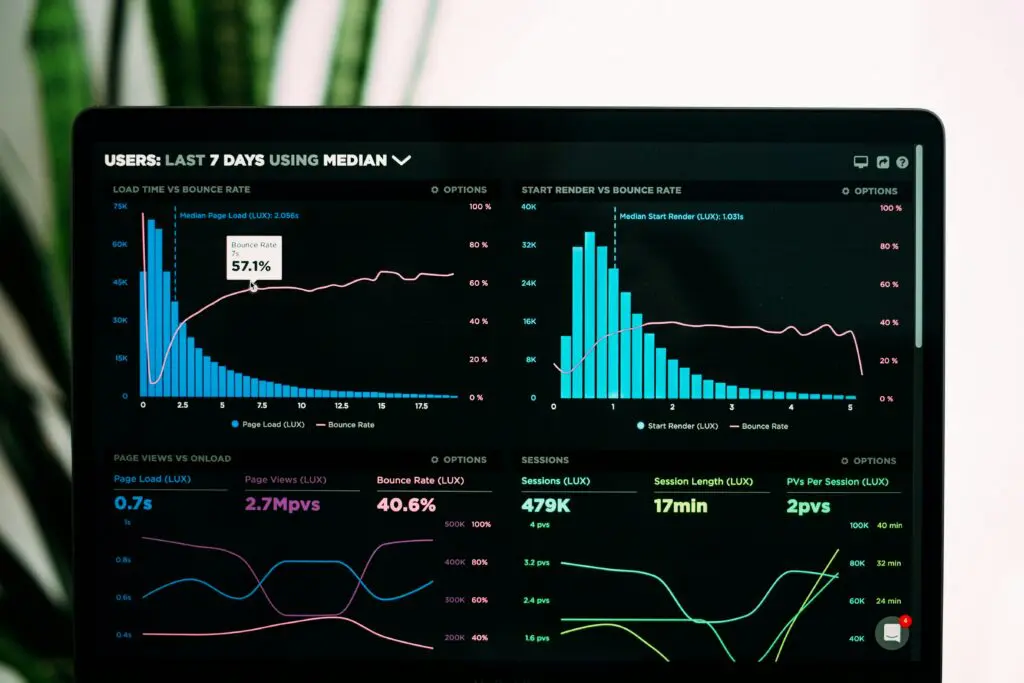Why understanding user behaviour is so important in eCommerce
Understanding the wants, needs, and intents of customers has always been essential to maximise customer satisfaction, and optimise conversions. Although a traditional SEO strategy for an eCommerce website is still crucial, it isn’t enough to compete with an ever-evolving world of tech-savvy businesses that are gaining increasing insights into user behaviour.

UBA is critical in modern eCommerce SEO strategies – Photo by Luke Chesser on Unsplash
Creating an SEO Strategy for eCommerce Websites
Creating an eCommerce SEO strategy requires considering more than keywords, search engines, and the results we are all familiar with in Google (SERPs).
For an overview of the most common SEO strategies proven to work, view our guide below; but if you want to know how to go one step further and create a modern SEO strategy based on actual user behaviour, continue reading.
In the old days, creating an SEO strategy for an eCommerce website, well any site really, was relatively straight-forward. The two principal ingredients were keywords and links. By placing keywords in the right places (e.g. URLs, meta data, text) and building inbound links from other websites, it was possible to rank well in search engines like Google and Bing.
Over the years, search engines have become a lot smarter, mainly thanks to their enhanced algorithms and AI. Competition has also become more fierce with more eCommerce websites competing for the same keywords.
These days, a modern eCommerce SEO strategy needs to think beyond metrics like keywords by considering user behaviour and the experience they encounter while using your site.
So what is the answer for a small to medium online retail business? How can smaller eCommerce websites adapt their SEO strategies?
In this guide, we will cover the importance of User Behaviour Analytics (UBA) and its role in helping businesses learn more about their customers while converting more sales — starting from search engine results pages and optimising until after the checkout process.
What is User Behaviour Analytics (UBA)?
UBA involves reviewing and investigating data to find user behaviour patterns. The difference with these types of analytics compared to others is that UBA focuses on the individual user in addition to an aggregated generalised spread of data collected from a group.
One of the key benefits of UBA is that it allows you to uncover trends in user behaviour that might not be immediately obvious through traditional SEO tools. For example, rather than focusing solely on metrics like rankings or bounce rates, UBA helps you get granular by breaking down user engagement on a page-by-page basis. You can identify, for example, which product images are getting the most attention, which CTAs are being ignored, or where users tend to scroll and then drop off.

Identifying eCommerce friction points and micro-conversions
It also helps to reveal micro-conversions. While eCommerce businesses often measure success based on major conversions, like completed purchases, UBA can help identify smaller, but equally significant user actions—like signing up for a newsletter, engaging with a product video, or adding items to a wishlist. These micro-conversions provide insight into what leads to the ultimate purchase decision, giving you a roadmap to refine content and user flows on a more granular level.
As well as highlighting problem areas; UBA can also show you what’s working. By analysing where users are spending the most time or which parts of the site have the highest interaction rates, businesses can double down on these elements.
Why UBA is an essential part of any modern eCommerce SEO strategy?
Leveraging UBA is particularly useful for eCommerce websites and it can play an important role in eCommerce SEO strategies.
This is because UBA allows webmasters to identify friction points which are barriers causing users to drop off within the conversion funnel.
eCommerce SEO has evolved to be about more than just optimising keywords and building backlinks—modern eCommerce SEO strategies require a more in-depth site-wide evaluation to keep up with the competition and meet the needs of customers.
Common friction points
Here are some examples of common friction points that eCommerce users commonly encounter:
- Slow eCommerce website load times (constant or intermittent)
- Convoluted checkout process
- Confusing navigation menus on web pages
- Technical issues and bugs
- Lack of product information
- Unclear instructions
UBA allows you to know rather than guess where the main problems are that are preventing your website from converting. This isn’t just for friction points, but for providing solid reliable objective data instead of subjective hunches that can be used to make reliable decisions.
Identifying friction points
Here is a quick example of how UBA could indicate a potential issue:
You notice that customers frequently use your website’s search function instead of navigating to the product, indicating poor website navigation.
Collecting and analysing user behaviour data
There are many types of insights that you can gain into user behaviour by monitoring analytics while adapting your search engine optimisation efforts and website design to cater to any friction points reflected in the data.
You should have an adaptive eCommerce SEO campaign that can be adjusted based on new data and understanding.
Click-through rates
Click-through rates measure how often a user clicks on your link after seeing it in search engines.
Having a higher click-through rate indicates that the content displayed matches the search intent and wants of the user searching. If this metric is low, then it indicates the links/content shown to users based on their search terms don’t match the needs of the user.
You can use search engine data and analytics to adjust and fine-tune your metadata (such as meta description and title) and content to reflect any issues you detect.
User behaviour patterns
Identifying user behaviour patterns is a huge benefit as it’s easy to spot content gaps, friction points, or other navigation issues that could be hurting conversions. You can also identify issues with internal linking (such as broken links) which can quickly be actioned and fixed to optimise the user journey.
Heatmaps
Another great set of tools at your disposal is heatmaps. Heatmap tools like HotJar allow you to see the most popular spots on your eCommerce website.
This is particularly useful when deciding where to place valuable content that you want a lot of eyes on. You can also fine-tune call-to-action areas which increase the likelihood of conversions or sign-ups depending on your goals.
Core web vitals
Your website’s health such as page load speeds and general usability is also part of UBA and can be improved through technical SEO strategies.
Webmasters can learn how their users respond to slow load times and instability and optimise their eCommerce website based on the gained data to improve the user experience. Carrying out technical SEO also extends to seeking out relevant broken links and fixing them, implementing structured data, and enhancing the site’s overall accessibility.
Internal links are important but if they become broken, this results in a bad user experience and has negative consequences for SEO.
Not only is this a worthy consideration for UX, but it is also a ranking factor for search engines that should be considered when evaluating the SEO strategy for your eCommerce website, or when forming new eCommerce SEO campaigns.
How to leverage UBA via A/B testing
It is essential to use UBA as part of a comprehensive strategy integrated with wider SEO efforts (such as relevant target keywords and optimised metadata) and tools such as Google Analytics.
One effective way to utilise insights and data gained from UBA is through A/B testing. Such practices should be carried out while respecting user privacy and ensuring GDPR compliance.

Improve your eCommerce SEO strategy using A/B testing
A/B testing leverages behavioural data to determine which features work better—or are more successful—on your website. This can be used to monitor the success of the checkout process, or even for simple things such as headings and website titles.
As a result, this will improve your customer’s experience and increase conversions once the necessary changes have been made to reflect customer behaviour. A/B testing tools such as Optimizely and VWO are popular and powerful tools that allow webmasters to test variations of webpages or various elements.
In addition to testing variations of headings and landing pages, A/B testing can be used to experiment with metadata variants based on user intent which can boost click-through rates and rankings in search engines.
Here are the main differences between the two most popular A/B testing tools.
Optimizely vs VWO
| Feature | Optimizely | VWO |
| Difficulty | User-friendly interface, but advanced setup may require technical expertise. | Intuitive interface, well-suited for both beginners and advanced users. |
| Target Audience | Large enterprises and organisations with complex testing needs. | Small to medium-sized businesses and enterprises. |
| Pricing | Enterprise-level pricing with custom quotes. | More affordable with multiple pricing tiers based on features. |
| A/B Testing Capabilities | Robust, advanced A/B testing with multivariate and server-side testing options. | Full A/B testing suite with additional multivariate and split URL testing. |
| Personalisation Features | Advanced personalisation options, including audience targeting and behaviour-based triggers. | Good personalisation features, but slightly less advanced compared to Optimizely. |
| Integration | Wide range of integrations with marketing tools, CRMs, and analytics platforms like Google Analytics, Salesforce, etc. | Also integrates with popular tools but has fewer integrations compared to Optimizely. |
| Reporting & Analytics | Deep analytics with advanced segmentation and customisable reports. | Strong analytics, with heatmaps, session recordings, and funnel analysis. |
| Scale | Built for large-scale experiments, ideal for teams needing complex testing frameworks. | Can handle large-scale experiments but may require higher-tier plans for more sophisticated features. |
| Mobile and Server-Side Testing | Offers strong server-side testing and robust mobile optimisation capabilities. | Supports mobile and server-side testing but with less flexibility than Optimizely. |
| Support & Resources | 24/7 support with a strong focus on enterprise customers. Extensive documentation and resources. | Offers strong customer support, including chat, email, and dedicated account managers for higher tiers. |
| Custom Code Testing | Allows for highly customisable testing with JavaScript code injection. | Supports code-based testing but less customisable for complex experiments. |
| Feedback Tools | Limited direct user feedback tools (can be integrated through third-party tools). | Comes with built-in tools like surveys, form analysis, and on-page feedback for user insights. |
Ways to use UBA with A/B testing
By harnessing A/B testing and wider UBA, businesses can do the following:
- Refine targeting: Create content and SEO strategies including eCommerce keyword research that targets what customers are searching for. Make data-driven decisions rather than making assumptions when it comes to keyword data.
- Improve UX: Create a consistent user experience starting at the search query stage and extending until post-purchase. Improve internal linking and encourage users to use website navigation rather than your website’s search feature.
- Be one step ahead: Analyse your gained behaviour analytics data and insights to stay ahead of the competition. Many businesses look to see what other eCommerce sites are doing rather than proactively make changes that are directly applicable to their own customers’ unmet wants and needs. Continue to perform eCommerce keyword research and refine your SEO efforts to increase click-throughs and lower bounce rates while keeping search engines happy.
- Personalisation: eCommerce businesses can utilise UBA to create personalised offers and marketing campaigns for customers based on browsing habits and purchase history. Personalisation increases the chances of new and repeat purchases from customers shopping online.
Personalisation in particular is a key aspect of UBA which can also drive loyalty and increased spending as seen in our infographic below:

UBA and personalisation infographic
Common mistakes to avoid in user behaviour analytics
If you are new to using behaviour analytics data it can be easy to make mistakes due to misinterpretations of the data generated by analytics. There are a few rules to live by to minimise false assumptions and ensure you can act in a way that is accurately based on user intent and generated insights.
Using single data sources
Using one source to interpret user data can be ineffective but can also lead to misunderstandings and misrepresentations regarding user behaviour. You should be treating the subsets of UBA as jigsaw pieces — it’s only when you pair them with other pieces that you can start to form a clearer understanding of user behaviour.
Data interpretation without context
Dig deeper into issues that are found in analytics and insights. For example, user click-through rate from search engines might be high but conversions may be low if there are friction points during the checkout process for example. Combine analytics to form understanding and context around the how, what, and why behind user behaviour.
Analytics echo chambers
When browsing analytics, be open-minded about what the data reveals. Don’t fall into the habit of looking for data to reinforce your pre-existing opinions or hunches. Let your decisions and opinions be led by the objective data gathered from a multitude of different behavioural insights.
Measuring optimisation
As the saying goes, “Vision without action is a daydream. Action without vision is a nightmare”. You can gather as much data as humanly possible but without taking action, it’s meaningless. Be sure to put your data to good use by making key changes based on data and data alone. This may require fundamental changes in addition to small adjustments, and fine-tuning until you can see measurable results.
Don’t abandon basic search engine optimisation
When focusing on UBA and A/B testing it’s easy to abandon your existing SEO strategy completely. Don’t do this.
SEO rankings are still determined by many different factors, therefore you should aim to have a comprehensive strategy that covers all bases—including keywords.
Your on-page SEO efforts should be adapted to fit with insights gained through your generated data. Optimising the meta description and title is still important along with the content that it represents on the search engine results page.
Keep looking for relevant keywords to improve search engine rankings at the same time as tightening up weaker parts of your website through technical SEO, UBA, and A/B testing.
Earning links naturally from good authority websites has benefits but be sure to stay away from artificially seeking out or farming/paying for what are thought to be ‘quality backlinks’.
Keep in mind complimentary tools outside of UBA such as Google Keyword Planner (link found here) and other keyword research tools that can further help with other areas of SEO.
Basic eCommerce SEO steps to take
- Take your first step in improving your eCommerce SEO by equipping your eCommerce store with UBA tools including Google Analytics.
- Install and analyse heatmap data from tools like HotJar.
- Fix internal links or eCommerce product pages that are broken and iron out any issues with navigation.
- Troubleshoot slow performance through application of technical SEO and refining the user experience.
- Make use of your keyword research tool to carry out keyword research to find long tail keywords, and other keywords that are relevant to your eCommerce website.
- Be constantly receptive to keyword ideas that may better describe your products or services.
- Run surveys to get user feedback on their experience using your site.
- Never stop monitoring and improving the user experience.
Conclusion
You should now have a better idea of how UBA and analytics in the broader sense can be used to improve conversions, audience retention, and help you to make data-driven decisions when creating a modern SEO strategy for eCommerce websites beyond just keywords.
Harnessing such data is invaluable for eCommerce websites in general and allows you to take the extra step ahead of your competitors. Use all types of web analytics to measure your shortcomings and also to track your successes based on A/B testing and making iterative adjustments.
As the eCommerce world becomes more competitive, every small decision you make can make a big difference. That is why harnessing these tools combined with keyword research and other eCommerce SEO strategies is essential to improve your marketing with more relevant keywords and better user experiences — all while pushing your site higher in search engine rankings.
For help or support with your eCommerce marketing, be sure to get in touch. If you have any questions about any of the points or services mentioned in this article or need help with optimising your eCommerce store, just let us know.,
Feel free to share your thoughts, suggestions, or experiences with eCommerce SEO in the comments below or get in touch with us on social media.

Adam is the lead content creator, marketing and emerging trends guru at eCommerce Agency. For the latest and greatest from Adam, stay tuned!


0 Comments